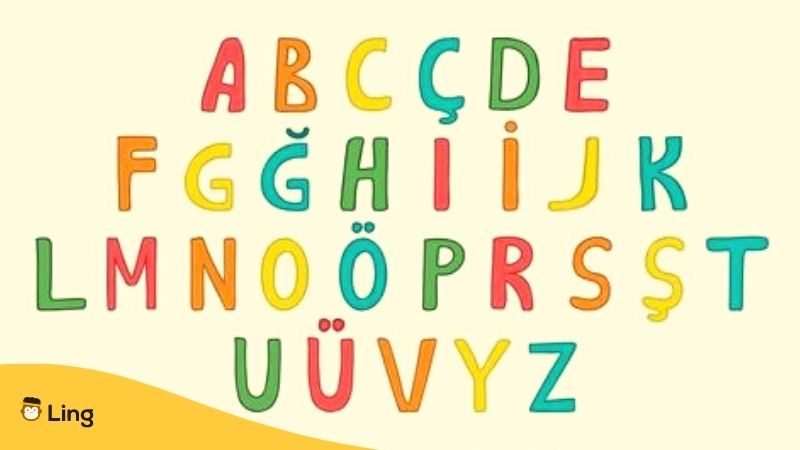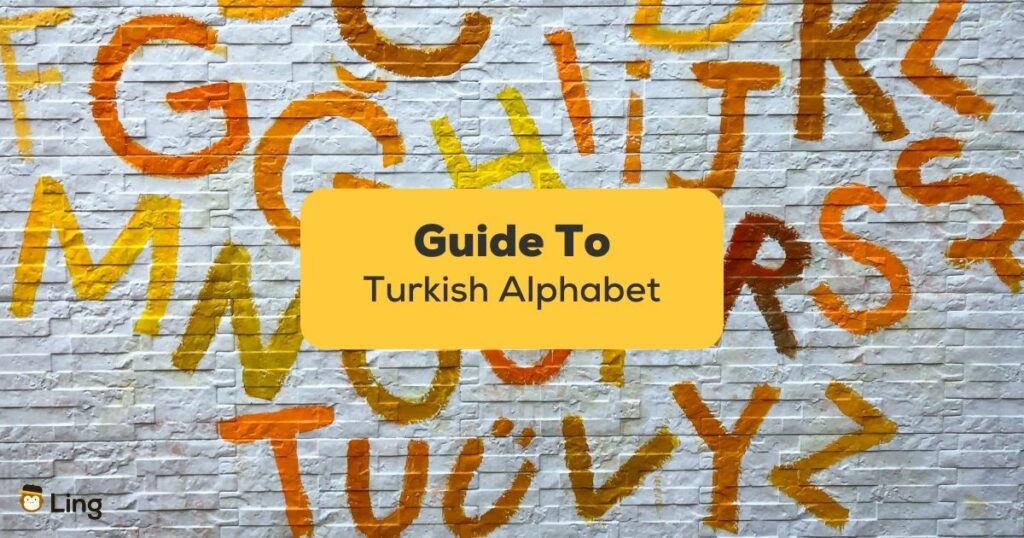Are you hesitating to start learning Turkish because of some odd-looking letters like “ğ, ö or ü?” Read this blog post to find out why the Turkish alphabet is actually easy to learn!
Do you want to learn Turkish but you’re intimidated by the difficult pronunciation of the Turkish language? Then you should start learning the Turkish alphabet today!
Mastering the alphabet is crucial in learning Turkish as the language’s phonetics is easier than most languages. How so? Because Turkish letters produce the same sound without any exceptions, unlike in English.
So, in this blog post, we’ll be covering the pronunciation of 29 letters in the Turkish alphabet as well as briefly touching upon some misconceptions about the Turkish alphabet and its background. If you’re ready, let’s get started!
Page Contents:
- Where Is Turkish Spoken?
- Is Turkish Written In Arabic?
- The Brief History Of The Turkish Alphabet
- The Turkish Script Is Easier Than You Think
- How To Pronounce Turkish Vowels
- How To Pronounce Turkish Consonants
- Learn Turkish In 10 Mins A Day With Ling!

Where Is Turkish Spoken?
Turkish is a very old language and the first written evidence of Turkish dates back to the 11th century. Turkish belongs to the Turkic language family.
Today, Turkish is the official language of two countries: Turkey (currently renamed as Türkiye), and Northern Cyprus. However, it is still spoken in a wide range of countries such as Bosnia and Herzegovina, Greece, Iraq, Kosovo, North Macedonia, and Romania. These countries recognize Turkish as a minority language.

Is Turkish Written In Arabic Script?
As a native speaker, I can attest that this is one of the biggest misconceptions about the Turkish people that we speak Arabic in Turkey while riding our camels. Here is a big NO! We neither speak Arabic nor use the Arabic script.
The Turkish language uses the Latin alphabet. Even though there are a lot of Arabic and Persian loanwords, Turkish is written in Latin script.
On the other hand, it’s true that in the Ottoman era, the official language was Ottoman Turkish and it was written with the Arabic alphabet. But as I said, that’s not the case in the modern era which is after the alphabet revolution in 1928.
The Brief History Of The Turkish Alphabet
In history, Turks have used various scripts. Some of them were antic alphabets such as Göktürk (Orhun), Uygur, Kiril, and Arabic.
When the Ottoman Empire fell and Mustafa Kemal Atatürk – known as the father of the Turks – appeared to rescue the fallen country. In 1928, several years after the Turkish Republic was formed, the Arabic alphabet was replaced with the Latin alphabet.
The Turkish Script Is Easier Than You Think
→ After, clearing up a few matters, let’s discuss why learning the Turkish alphabet is easier than it seems.
→ Unlike French or English, the Turkish alphabet is phonetic. Meaning, Turkish letters are produced in only one way. They have the same spelling in all words.
→ The Turkish alphabet lacks the three letters “q, w, and x” that exist in the English alphabet.
→ The Turkish alphabet consists of 29 letters. It follows the order of the Latin alphabet with some additions such as “ü, i, ö, ç, ğ, and ş.”
→ Loanwords that include “c” are written and pronounced with “k.” Additionally, most of the French loanwords starting with “s” take the prefix “–i” in Modern Turkish pronunciation.
→ The Turkish soft g (ğ) looks like a troublemaker but you actually don’t pronounce it. Just pretend it doesn’t exist and pronounce the remaining letters.

How To Pronounce Turkish Vowels
Here is the list of Turkish vowels. We showed how to pronounce them through English words. Pay attention to the dotted vowels!
- A – sounds like “ah” as in awful
- E – sounds like “eh” as in hey
- I – sounds like “ə” as in the
- İ – sounds like “i” as in inside
- O – sounds like “o” as in oven
- Ö – sounds like “i” as in bird
- U – sounds like “oo” as in noodles
- Ü – sounds like “ü” as in astute
How To Pronounce Turkish Consonants
Here is the list of Turkish consonants. We showed how to pronounce them through English words.
- B – sounds like “b” as in bar
- C – sounds like “j” as in jean
- Ç – sounds like “ch” as in cheap
- D – sounds like “d” as in dog
- F – sounds like “f” as in fur
- G – sounds like “g” as in go
- Ğ – silent letter
- H – sounds like “h” as in here
- J – sounds like “ge” as in mirage
- K – a sounds like “k” as in kite
- L – sounds like “l” as in like
- M – sounds like “m” as in man
- N – sounds like “n” as in no
- P – sounds like “p” as in pick
- R – sounds like “r” as in ramp
- S – sounds like “s” as in super
- Ş – sounds like “sh” as in she
- T – sounds like “t” as in tan
- V – sounds like “v” as in vet
- Y – sounds like “y” as in yes
- Z – sounds like “z” as in zoo
In the end, the Turkish alphabet and pronunciation aren’t that hard, right? If you want to kickstart learning Turkish from scratch, download Ling today and use it every day for only 10 mins! Read below for more information about Ling!
Learn Turkish In 10 Mins A Day With Ling!
If you are thinking about learning Turkish or other languages, waste no more time and check out Ling to get started today!

Ling is a language learning app designed to help all language learners from beginning their language learning journeys. The app consists of various engaging activities, such as writing and listening exercises, quick quizzes, and an AI chatbot to practice your conversation skills. Ling offers you everything you’re looking for in a language-learning app.
Also, don’t forget to check out our Turkish blog for weekly articles related to the Turkish language and culture!
Trust me; you won’t regret it if you give Ling a try for FREE by simply downloading it from the App Store or Play Store.
Until next time! Görüşürüz!

























